
By Delaney Taber
On Sept. 18, Pinellas County’s decision to cut more than $1 million in funding for Creative Pinellas put local arts programs and community projects in a state of uncertainty. With the money redirected toward tourism-focused grants, artists and community members explored ways to adapt, find new funding sources and keep creative initiatives alive.
Local artist Ashley Cassens, who has worked on two murals supported by Creative Pinellas over the past two years, including a project in South Pasadena at the Florida Orange Groves winery, said she was surprised when she first heard about the funding cut.
“It was pretty shocking because it seemed kind of like it came out of nowhere,” Cassens said. “As an artist, I can only speak from my personal experience, like, St. Pete and Creative Pinellas are absolutely amazing at creating opportunities for art and community.”
Looking ahead, Cassens said she’s uncertain how the restructuring would play out and whether opportunities for artists would be preserved.
“From what I understand about how they’re going to restructure it is that they’re going to basically hand this off to Visit St. Pete–Clearwater, which is the other organization,” Cassens said. “My thinking is that they’re going to end up hiring art consultants… but that’s still funding, so I’m not really sure how that is gonna work.”
Visit St. Pete–Clearwater, the county’s Convention and Visitors Bureau (CVB), serves as the official tourism bureau promoting the area as a travel destination. As part of the funding shift, county commissioners redirected about $500,000 to the organization to develop a new arts tourism grant program aimed at marketing Pinellas County through the arts.
She added that while the funding might still exist in some form, the shift raised questions about how projects will be managed and whether artists will have the same access to opportunities.
“It just seems kind of like apples to oranges in terms of we’re gonna call it something else and it’s gonna do the same thing, but we’re just gonna give it to another organization,” Cassens said. “I don’t know, it just seems weird.”
While Cassens worried about losing vital support, economist and an associate professor of economics at USF Sarasota-Manatee, Michael Snipes, saw broader ripple effects on the county’s economy and cultural identity.
“The arts play a really important role not just in kind of boosting the economy, but also kind of giving people a sense of community or a sense of kind of this is what it needs to be in Florida and we express that through the arts,” Snipes said. “It’s kind of interesting because the arts in a lot of ways is its own tourism draw.”
As for solutions, Snipes pointed to private philanthropy as one way the arts could withstand public funding cuts. He noted that expanding those kinds of private support systems could help fill the gap left by the county’s decision.
“We do traditionally have a pretty strong tradition of private funding, of grants coming from non-governmental institutions, of philanthropy or people giving part of their estate to the creative arts and museums and galleries,” Snipes said.
He pointed out that while the effects of the budget cut to Creative Pinellas might not be “catastrophic,” the loss would still be felt and private funding could provide some cushion.
“So kind of the better and more organized kind of private funding is,” Snipes said. “I mean, it’s not going to be a perfect substitute, but it is going to provide a better shield for kind of the zeitgeist and the winds of political winds.”
Pinellas County Commissioner René Flowers, one of two commissioners who voted against the funding cut, provided insight into the county’s decision-making process and what it meant for Creative Pinellas moving forward.
Flowers shared that the decision largely stemmed from Commissioner Brian Scott’s concerns about the county’s return on investment.
“His feeling was that the county was experiencing little return on the funding,” Flowers said.
Creative Pinellas was subsequently invited to work with the St. Petersburg Arts Alliance to help the CVB develop the new grant system, Flowers explained. However, she described it as contradictory to seek their guidance after questioning the organization’s effectiveness, underscoring the tension in the commission’s approach.
“It’s my understanding now that Creative Pinellas has been asked to participate along with the Arts Alliance in helping the CVB develop the tool that will be provided to artists to apply for funding,” Flowers said. “I think it’s kind of ironic because if they weren’t lending anything to the environment or if they weren’t providing a great rate of return, why would you have someone you say is not effective help construct a new program outline?”
Flowers added that she hoped local governments and private businesses could collaborate to keep arts programs alive during the transition.
“I would hope that local businesses, corporations, and nonprofit entities could speak with the St. Petersburg City Council to see if they would be willing to bolster their current program,” Flowers said.
In a written statement following the commission’s decision, Creative Pinellas CEO Margaret Murray said the organization was “very disappointed and disheartened” by the county’s move to cut funding.
“We are deeply grateful for the county’s past financial support, and would have loved the opportunity to continue working with them as the fiscally responsible partners and innovative, creative collaborators we have been since 2011,” Murray said in the statement.
She added that while the loss presented new challenges, Creative Pinellas remained committed to supporting artists and community programs across the county. The organization is focused on rebuilding and reinventing itself, starting with its upcoming Arts Annual 8 fundraiser and exhibition on Nov. 21



